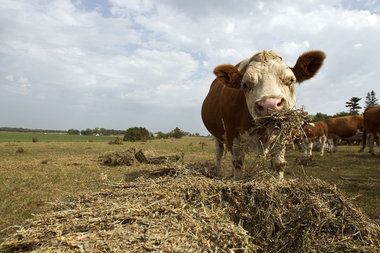What a turn around to the season in northern NSW! I’ve been out on a number of places from Tamworth to Lightning Ridge in the last few weeks. Everywhere I’ve been I’ve been struck by how much growth is occurring in pastures and crops.
Of course many of my clients in southern NSW and even on the New England are still in the cold grip of winter, but the days are getting longer and warmer, and I think their turn for the season to kick away isn’t far off.
As we move into spring or if you are already grazing some of this new growth, don’t forget the season will bring a few challenges with it.
The two greatest challenges will come from bloat and from the clostridial disease Enterotoxaemia or Pulpy Kidney. Now I know I’ve written about both of these in previous blogs, but it’s worth spending some time to refresh your knowledge on both of these issues.
Bloat
Bloat is caused by the release of gas caused by the digestion of lush pasture material. Normally cattle do a pretty good job in belching out this gas. However legumes and some lush pastures produces foam that builds up in the rumen during digestion. This foam traps the gas and prevents the animal from belching the gas out.
Meanwhile the rumination process continues to occur, producing more gas and more foam, and the pressure inside the rumen continues to build. If the foam doesn’t break down the gas remains trapped, and the pressure increases until the internal organs are crushed and the animal dies.
A real issue with boat is there is no silver bullet to prevent it occurring. I know many producers hope that one single strategy will solve their concerns. Unfortunately there isn’t a single 100% prevention.
Strategies that can work will include:
Restrict pasture intake by limiting grazing time or strip grazing
Don't place hungry cattle onto lush green pastures, particularly if it is high in legume content
It can be useful to allow cattle access to older grass pastures or hay when grazing potential bloat risk pastures
I know many producers do use bloat capsules, bloat blocks and even licks as well as medicating water supplies with a bloat oil. Its important to remember these options have limitations. Animal consumption of these products is pretty variable. So you cant be certain that ever animal is using the product or that they have consumed enough or even if they are regularly using the products.
Don’t forget bloat capsules are not always available when you need them. They also take a few days to take effect and this means animals are still at risk just after they receive the capsule. If you are trying to apply bloat oil in water troughs remember if cattle can access water in other ways they may not use medicated water in troughs.
Bloat is such a challenge, and the only effective strategy is to use a number of treatments and prevention strategies in combination to reduce your risk as much as possible.
Pulpy Kidney
Pulpy Kidney can be a significant contributor to losses on lush pastures. It can be a really big issue for many lamb producers, but cattle losses can also be fairly high in some circumstances.
Clostridial bacteria that live in the intestines of the animals cause the disease. Under the right conditions, generally when there is a rapid change to flow of feed through the digestive system the bacteria multiply. This rapid increase produces enough toxins to overwhelm the animal’s immune system and death happens pretty swiftly.
Fortunately the disease can be prevented through the use of the 5 in 1 vaccine. However it’s important to remember that the component of the vaccine that controls Pulpy Kidney will decline reasonably swiftly.
So if you are looking at a good season and planning to graze lush pastures for 2 or 3 months, I‘d recommend you consider regular 5 in 1 boosters while you are grazing that feed. To work out when to give the boosters make sure you read the label.
Don’t forget if you are unsure or you need some input to make the most of the conditions ahead, you can always get in contact with me.







